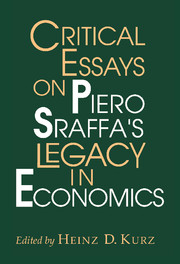Book contents
- Frontmatter
- Contents
- Preface
- List of contributors
- Part I Introduction
- Part II Returns to scale, demand, money and interest, and the classical tradition
- Part III Long-period theory and the problem of capital
- 7 The capital theory controversy
- 8 Wicksell and Douglas on distribution and marginal productivity
- 9 On the probability of re-switching and capital reversing in a two-sector Sraffian model
- Part IV Intertemporal equilibrium theory and the problem of capital
- Mathematical Note by Michele Tucci
- Author index
- Subject index
9 - On the probability of re-switching and capital reversing in a two-sector Sraffian model
Published online by Cambridge University Press: 05 June 2012
- Frontmatter
- Contents
- Preface
- List of contributors
- Part I Introduction
- Part II Returns to scale, demand, money and interest, and the classical tradition
- Part III Long-period theory and the problem of capital
- 7 The capital theory controversy
- 8 Wicksell and Douglas on distribution and marginal productivity
- 9 On the probability of re-switching and capital reversing in a two-sector Sraffian model
- Part IV Intertemporal equilibrium theory and the problem of capital
- Mathematical Note by Michele Tucci
- Author index
- Subject index
Summary
Introduction
In his classic Production of Commodities by Means of Commodities (1960), Piero Sraffa claimed (in Chapter XII) that a technique of production which was most profitable at one rate of profit (interest) could become inferior to another technique at a higher rate and then reappear as the most profitable at a yet higher rate. This phenomenon, known as the ‘re-switching’ of techniques, has profound implications for the logic of using aggregate concepts of capital and the standard monotonic relationships between ‘factor’ quantities and prices derived there from (see Harcourt, 1972, and, for a recent exposition, Ahmad, 1991). Sraffa's claim was the subject of intense debate in a symposium (1966) in the Quarterly Journal of Economics, and subsequently in papers by Galloway and Shukla (1974), Garegnani (1970, 1976), Sato (1976) and Laibman and Nell (1977). The outcome established categorically the possibility of re-switching in general multisector models of production, but despite these demonstrations of ‘possibility’, the question of ‘probability’ has received far less attention.
Apart from some early statements of (generally quite weak) sufficiency conditions for non-re-switching (e.g. Bruno, Burmeister and Sheshinski, 1966, p. 544), there have been few explicit attempts in the theoretical literature to deal with this question. One of the first was by Eltis (1973, Chap. 5), who considered the matter in relation to the two-sector model of Hicks (1965) and to his own particular variant of the model.
- Type
- Chapter
- Information
- Critical Essays on Piero Sraffa's Legacy in Economics , pp. 323 - 360Publisher: Cambridge University PressPrint publication year: 2000
- 12
- Cited by

